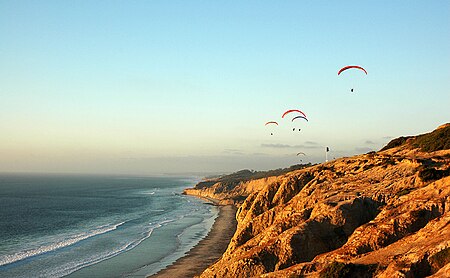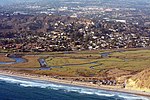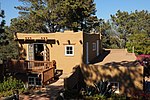Torrey Pines State Beach

Torrey Pines State Beach is a public beach located in the San Diego, California community of Torrey Pines, south of Del Mar and north of La Jolla. Coastal erosion from the adjacent Torrey Pines State Reserve makes for a picturesque landscape. It is a local favorite among surfers and remains a quintessential Southern California beach. Occurrences of bioluminescence in the waters near the beach have been noted.The beach is at the base of a series of 300-foot sandstone cliffs of white and golden stone, with a greenish layer sometimes visible at the very bottom. At the north end of the beach the cliffs end and Los Peñasquitos Lagoon, a salt marsh estuary, empties into the ocean. A county highway crosses the entrance, with limited free parking along the beach.
Excerpt from the Wikipedia article Torrey Pines State Beach (License: CC BY-SA 3.0, Authors, Images).Torrey Pines State Beach
North Torrey Pines Road, San Diego
Geographical coordinates (GPS) Address Nearby Places Show on map
Geographical coordinates (GPS)
| Latitude | Longitude |
|---|---|
| N 32.931388888889 ° | E -117.26027777778 ° |
Address
North Torrey Pines Road
North Torrey Pines Road
92014 San Diego
California, United States
Open on Google Maps






